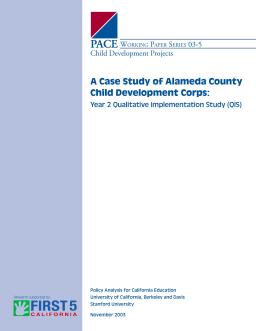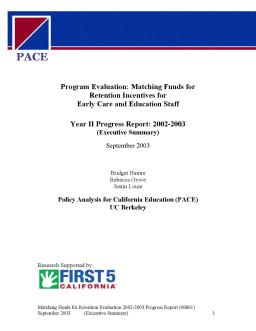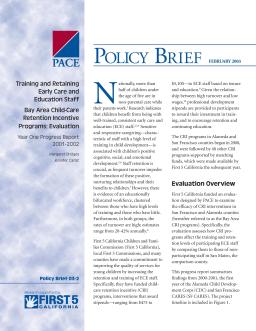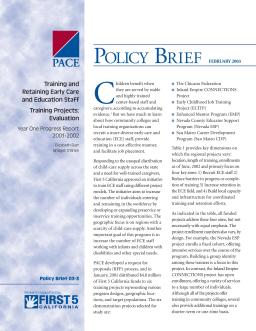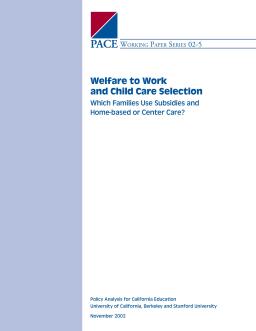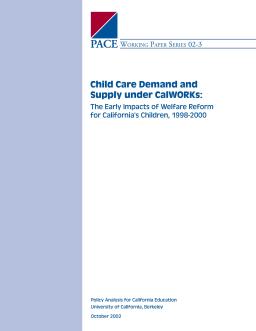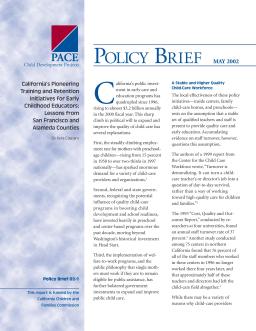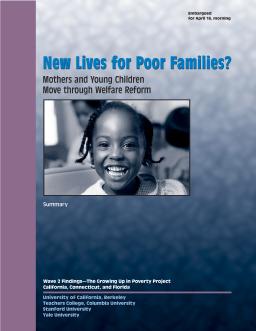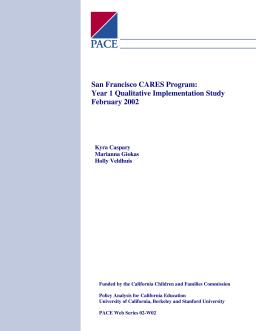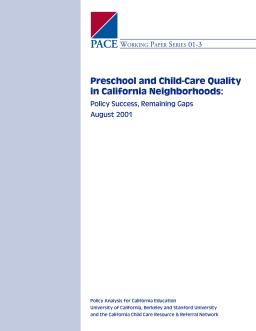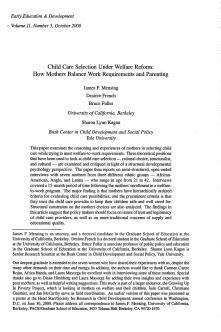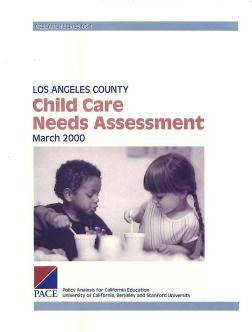Year 2 Qualitative Implementation Study (QIS)
Published
Summary
This paper discusses the second year of Alameda County’s Child Development Corps program as a childcare retention-incentive program. The program's goals were to encourage staff training, professional development, and establish a strong network of ECE professionals. Stipend recipients were pleased with the program but recognized that it could not function alone in addressing staff retention, and a larger system of support and advocacy was necessary.
Year Two Progress Report, 2002–03—Executive Summary
Published
Summary
This report highlights findings from a 2002-03 progress report on First 5 California's childcare retention incentive programs, aimed at improving retention and increasing training among early care and education staff. Data were collected from ten counties through a phone survey of participants and site visits. Initial findings related to program design and implementation, program participation, training and professional development, and retention are summarized.
Bay Area Childcare Retention Incentive Programs Evaluation—Year One Progress Report, 2001–02
Published
Summary
The First 5 California Children and Families Commission has funded the Childcare Retention Incentive (CRI) to improve the quality of early care and education (ECE) staff training and retention. An evaluation funded by First 5 California assesses the efficacy of CRI programs in San Francisco and Alameda counties. This report summarizes the preliminary findings from the first year of the Alameda Child Development Corps and San Francisco CARES programs, which examine whether CRI recipients are more likely to participate in training and be retained compared to non-participating ECE staff.
Year One Progress Report, 2001–2002
Published
Summary
This policy brief examines the effectiveness of childcare retention incentive (CRI) programs in selected California counties. It assesses program design, participant characteristics, training activities, and retention rates among early care and education staff. The study aims to identify the impact of CRI programs on the stability and training of the ECE workforce, which is critical for improving the quality of care for children.
Evaluation Year One Progress—Report 2001–02
Published
Summary
First 5 California approved an initiative to train early care and education (ECE) staff in regions with a scarcity of childcare supply. Six training projects were selected, which provide community college training and additional training on a shorter-term or one-time basis. The goal is to increase the number of individuals entering and remaining in the ECE workforce and to increase the number of ECE staff working with infants and children with disabilities and other special needs.
Which Families to Serve First? Who Will Respond?
Published
Summary
This paper discusses extending access to preschool for families in California, focusing on targeting priorities to yield strong enrollment demand and discernible effects on young children's early development and school readiness. It analyzes different targeting mechanisms and suggests experimenting with alternative expansion strategies, rather than investing exclusively in one method. The report also describes which communities would benefit most and considers the criteria for judging the wisdom of targeting options.
Which Families Use Subsidies and Home-Based or Center Care?
Published
Summary
Public spending on childcare has increased, but low-income families still face barriers to accessing subsidies. This working paper examines the choices made by 1,974 parents in California who moved from welfare to work and needed childcare. The study found that parents relied on a mix of formal and informal childcare options, and that the expansion of one form of care did not necessarily influence parents' choices.
The Early Impacts of Welfare Reform for California's Children, 1998–2000
Published
Summary
This report examines the effects of welfare-to-work and childcare capacity building on the childcare system in California, prompted by changes in the childcare system and welfare reform. The study was requested by the California Department of Social Services, and this paper provides an overview of the findings.
Descriptive Findings from the Child Care Subsidy Interview
Published
Summary
CDSS and PACE conducted a survey of CalWORKs participants in Kern, Orange, and Santa Clara counties, interviewing 1,974 individuals in three languages. This report presents demographic data and survey responses, including frequencies and select responses by county, language, and ethnic groups.
California Families See Little Growth in Child Care Centers
Published
Summary
The rise in the number of working mothers has led to a greater need for childcare, and investments have been made to support early education. California's childcare programs have seen a surge in funding, including a tax credit program. The policy brief aims to explore if the increased funding has improved access to quality childcare centers and preschools for California families.
Findings from the Child Care Providers Focus Groups
Published
Summary
This report presents findings from PACE's study on how California's childcare subsidy system and CalWORKs program impact licensed and license-exempt childcare providers. Five focus groups were conducted in 1999 and 2000, with topics organized by providers' services, philosophies of care, operational issues, and opinions about the subsidy system. The report provides insight into the experiences of childcare providers across California, but does not claim to be representative of the industry.
Lessons from San Francisco and Alameda Counties
Published
Summary
The policy brief discusses the reasons behind California's increase in public investment in early care and education programs, including the rising demand for childcare, recognition of the potential benefits for child development and school readiness, and the implementation of welfare-to-work programs with results and insights from both San Francisco and Alameda Counties.
Mothers and Young Children Move Through Welfare Reform
Published
Summary
This report discusses the lack of knowledge about the impact of welfare-to-work programs on young children since 1996, and how policy leaders are debating ways to aid jobless mothers and enrich their children's lives. The project team followed 948 mothers and preschool-age children for two to four years after the women entered new welfare programs in California, Connecticut, and Florida.
Mothers and Young Children Move Through Welfare Reform: Executive Summary
Published
Summary
This report examines how welfare-to-work programs have affected the lives of young children since 1996, and how they've impacted the home and childcare settings in which they are raised. The study followed 948 mothers and preschool-age children in California, Connecticut, and Florida for two to four years, using interviews, assessments, and visits to homes and childcare settings. The report highlights the major findings from the study.
Year 1—Qualitative Implementation Study
Published
Summary
This report on San Francisco County’s CARES program (SF CARES) provides guidance for policymakers, program administrators, and childcare advocates planning similar initiatives. PACE collected feedback from program planners, stipend recipients, and other childcare community members on aspects of the planning and implementation process. SF CARES successfully distributed over 400 stipends in the program’s first year, but challenges remain in reaching a broader array of childcare providers and communicating program goals.
Year 1—Qualitative Implementation Study
Published
Summary
This report provides guidance on implementing childcare retention initiatives based on Alameda County’s Child Development Corps program. PACE conducted focus groups with stakeholders to gather feedback on the planning and implementation process. The program saw increased commitment from providers to their profession and seeking training opportunities, but challenges remain with fitting permit requirements to family providers and relevance of courses.
Published
Summary
This article discusses the role of childcare in promoting the development and opportunities for low-income children, noting that federal and state funding for childcare has increased dramatically since welfare reform. Despite this, children from poor households are less likely to be enrolled in high-quality programs than children from affluent families. To achieve welfare reform's goal of breaking the cycle of intergenerational poverty, welfare-to-work programs should increase access to high-quality childcare in low-income neighborhoods.
Published
Summary
This report discusses an initiative by the California Children and Families Commission to expand the availability and quality of early care and education programs. The project includes recruiting and training early care providers, improving professional preparation, and implementing strategies to retain trained providers. The report provides information on existing training programs available to early childhood professionals and students, including accredited/non-accredited opportunities at community colleges, state universities, private colleges, and child care resource and referral agencies.
Policy Success, Remaining Gaps
Published
Summary
This paper analyzes the quality of center-based programs in diverse lower-income communities in California. The majority of centers displayed high levels of quality, and community conditions such as poverty levels and ethnic composition did not consistently influence quality. Public subsidies positively affected center quality, while the presence of more programs in a community may slightly lower quality due to increased demand for enrollment.
Focusing on San Francisco and Santa Clara Counties
Published
Summary
This report analyzes California's early childhood education programs and finds that attending public preschool programs improves school readiness and academic performance, particularly for low-income children. The study also shows that the economic benefits of preschool programs far outweigh the costs, including increased earnings and decreased need for remedial education and social services. Recommendations include expanding access to high-quality preschool programs for low-income children in California to reduce economic inequality.
New Lessons for Los Angeles
Published
Summary
California is experiencing a shortage of quality childcare options for families, despite increased funding from the government and parents. Local policymakers in Los Angeles County are conducting research to determine where childcare supply falls short of demand and how to allocate resources to address the issue. Two recent studies provide options for policymakers to consider.
Local Innovations Help Working Families
Published
Summary
Many low-income families struggle to afford childcare, even with financial supports. Less than one-fourth of eligible families sign up for subsidies in many communities, leading to disparities in access. The What Works series examines effective programs and policy strategies to increase participation in childcare subsidy programs. The report draws from the Growing Up in Poverty Project, which found highly variable rates of eligible parents using childcare subsidies across CA, CT, and FL. Possible reasons for low utilization and present novel strategies to increase participation are discussed.
How Mothers Balance Work Requirements and Parenting
Published
Summary
This paper examines how mothers select childcare to meet welfare-to-work requirements. Interviews with seven mothers from different ethnic groups show that trust in childcare providers to keep their children safe is the most important criterion. Structural constraints on their choices are also analyzed. The findings suggest that policymakers should focus on trust and legitimacy of childcare providers in addition to supply and educational quality.
Published
Summary
Governments are expanding the availability of portable child-care vouchers to boost working parents' purchasing power, rather than simply building more child-care facilities. Despite this, parents in poor communities still have limited choices due to cost and supply. Many eligible parents are not using subsidies, resulting in high out-of-pocket expenses for child care. Low-income working mothers make tough choices, working more hours or relying on informal providers, resulting in several transitions for children throughout the week, which experts suggest is not good for young children.
Published
Summary
A study conducted for the Los Angeles County Department of Public Social Services aimed to determine the supply and demand of licensed childcare in the county, with a focus on low-income communities and special types of care. The survey analyzed data at three levels: county-wide, service planning areas, and supervisorial districts. Results showed disparities in childcare supply across the county, with shortages in special types of care and little information on where childcare is needed.
